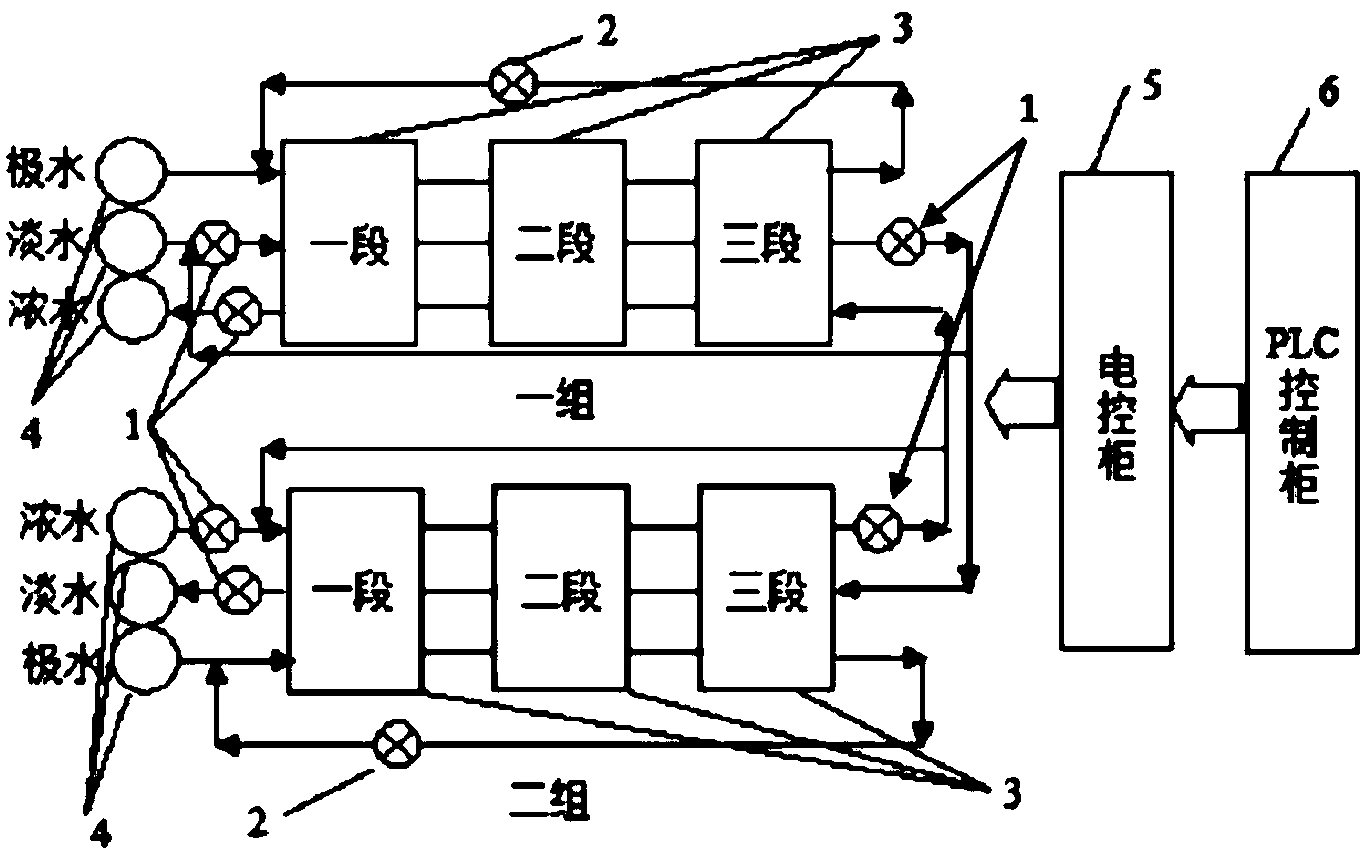Multi-stage countercurrent electrodialyzer reversal-based method for treating saline wastewater in coal chemical industry
A technology of inverted electrodialysis and saline wastewater, which is applied in the fields of water/sewage multi-stage treatment, chemical instruments and methods, water/sludge/sewage treatment, etc. High cost and other issues, to achieve the effects of prolonged membrane cleaning cycle, high fresh water recovery rate, and high fresh water yield
- Summary
- Abstract
- Description
- Claims
- Application Information
AI Technical Summary
Problems solved by technology
Method used
Image
Examples
Embodiment 1
[0037] Example 1 Simulation of Electrodialysis Desalination of Coal Chemical Industry Salt Wastewater
[0038] Electrodialysis technology was used to treat simulated coal chemical industry saline wastewater, and the effects of different initial Cl- ions in concentrated water and fresh water on desalination rate, energy consumption and membrane stack voltage were investigated. Studies have shown that when the initial concentration of Cl- in fresh water is 600 mg / L, and the initial concentration of concentrated water is 1200, 5000 and 8000 mg / L, under constant pressure conditions, the resistance increases with the reduction of the salt content of fresh water, which can lead to The current density drops. In 150 minutes, the concentration of Cl- ions in fresh water can be reduced to below 250 mg / L. When the concentration of Cl- ions in concentrated water is high, the removal rate of Cl- ions slows down. The reason is speculated to be the reverse diffusion of Cl- ions in concentrat...
Embodiment 2
[0039] Example 2 Electrodialysis desalination of actual coal chemical industry saline wastewater
[0040]Taking the external drainage of the biological aerated filter in the coal chemical industry as an example, although it has reached the industrial wastewater discharge standard, its recycling is limited due to the presence of inorganic salts such as Cl- ions, a small amount of refractory organic matter, suspended particles and bacteria, etc. Remove inorganic ions such as Cl- and other pollutants. Electrodialysis technology is used for desalination treatment, and constant potential operation is adopted. Concentrated water and fresh water are filtered with 5 μm PP cotton and then directly used as water for electrodialysis system. Wastewater is similar, and under the same desalination conditions, the Cl-ion in fresh water drops to less than 250mg / L to meet the reuse standard. However, in each batch of experiments, the current density showed a downward trend with the desalinati...
Embodiment 3
[0042] Example 3 Multi-stage countercurrent reverse electrode electrodialysis treatment of actual coal chemical industry salty wastewater
[0043] Aiming at the external drainage of coal chemical aerated biological filter of large-scale iron and steel enterprises in China (referred to as coal chemical saline wastewater), although the discharge standard has been met, the wastewater still contains a small amount of refractory organic matter, soluble inorganic salts, Ca 2+ and Mg 2+ Ions, suspended solids, colloids, chroma and other impurities, etc., are directly treated by multi-stage countercurrent reverse electrode electrodialysis after sand filtration. After the system has been in operation for 5 days, it is found that the current density gradually decreases under the same applied voltage, resulting in the desalination rate of electrodialysis. The desalination rate per unit of wastewater is also greatly reduced, and the membrane resistance is significantly increased, making i...
PUM
 Login to View More
Login to View More Abstract
Description
Claims
Application Information
 Login to View More
Login to View More - R&D
- Intellectual Property
- Life Sciences
- Materials
- Tech Scout
- Unparalleled Data Quality
- Higher Quality Content
- 60% Fewer Hallucinations
Browse by: Latest US Patents, China's latest patents, Technical Efficacy Thesaurus, Application Domain, Technology Topic, Popular Technical Reports.
© 2025 PatSnap. All rights reserved.Legal|Privacy policy|Modern Slavery Act Transparency Statement|Sitemap|About US| Contact US: help@patsnap.com


